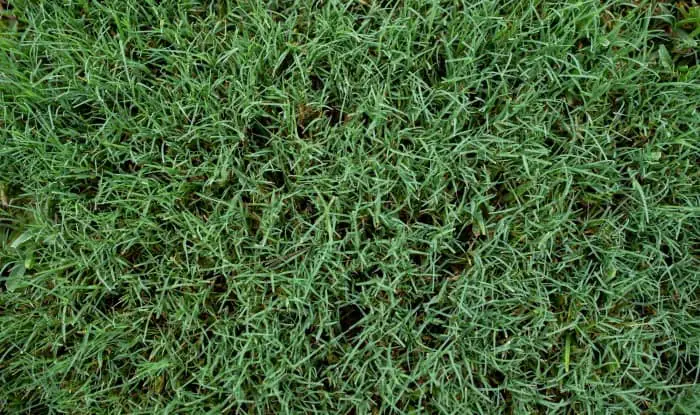One of the best ways of keeping weeds out of your Bermuda grass lawn is to use a pre-emergent.
But unfortunately, not all pre-emergent chemicals are safe to use on this popular warm-season turfgrass. So it’s vital to choose the right one.
The best pre-emergent for Bermuda grass is The Andersons DG Pro Turf Barricade.
This highly effective pre-emergent herbicide is safe to use on Bermuda grass. And has an excellent reputation with customers for control of summer and winter annual weeds.
The top choices at a glance:
All links lead to Amazon, where you can find more information & customer reviews.
The Top Pre-emergents For Bermuda Grass
The Andersons DG Pro Turf Barricade Granular Weed Control
The Anderson’s Barricade is a well-known brand of pre-emergent herbicide that provides excellent weed control.
Barricade is a granular herbicide that’s easy to spread over your lawn. And after you water the pre-emergent into the soil, it forms a chemical barrier that prevents weeds from developing.
But because Barricade is a pre-emergent, you can’t use it to control weeds that are already growing in your yard.
For effective control of summer-annual weeds, use Barricade in the early spring. Ideally, a couple of weeks before weed seeds germinate. To control winter-annual weeds, apply the herbicide in late summer to early fall.
Barricade contains the active ingredient prodiamine, a pre-emergent chemical that prevents most annual broadleaf weeds and grasses. Weeds controlled by prodiamine include henbit, plantain, dandelion, chickweed, carpetweed, purslane, oxalis, crabgrass, and annual bluegrass (Poa annua).
The product comes in 2 different sized bags — a 40 lb bag covering 12,800 sq. ft. And an 18 lb bag that contains enough pre-emergent to treat a 5,800 ft. area. You can spread the granules evenly over your lawn using a spreader.
Quali-Pro Prodiamine 65 WDG
This product is another pre-emergent herbicide that uses prodiamine. It controls over 40 broadleaf and grassy weeds, including common summer-annual weeds and cool-season weeds. Weeds it can control include henbit, foxtail, knotweed, Poa annua, goosegrass, spurge, lambs quarters, and chickweed.
You can use this pre-emergnt on lawns and golf courses as long as the turfgrass is established. And it’s also suitable for use around landscape ornamental plants.
The product comes in a 5 lb container of granules, but you don’t use a spreader to apply the pre-emergent. Instead, mix the granules with water and apply using a tank sprayer.
You can also mix this herbicide in the same tank as fertilizer and pesticides by following the provided mixing instructions.
Dimension 2EW Dithiopyr Pre-Emergent Herbicide
Dimension is a liquid pre-emergent herbicide. Some people prefer liquid pre-emergents as they find it easier to get even coverage of their Bermuda grass lawn.
Dimension contains dithiopyr, a pre-emergent chemical safe to use on Bermuda grass. It gives you good control of annual grassy and broadleaf weeds. And it also provides early post-emergent control of crabgrass.
Dithiopyr is a common choice for professionals using pre-emergent herbicide in commercial settings such as parks, athletic fields, golf courses, and playgrounds. But dithiopyr is also a good pre-emergent for use on your lawn.
It’s worth being aware that you will have to wait 3-4 months after using Dimension before reseeding or overseeding.
Scotts Halts Crabgrass And Grassy Weed Preventer
Scotts Halts Crabgrass and Grassy Weed Preventer is a granular pre-emergent herbicide that controls grassy weeds and broadleaf weeds. The company claims that one application in the spring is enough to control crabgrass.
It contains the pre-emergent herbicide pendimethalin, a safe chemical for Bermuda grass.
Scotts Halts is good for controlling summer and winter annual weeds. You can also use this pre-emergent in the fall to prevent moss from growing. But you should limit your use of this product to a couple of times per year. And leave a couple of months between applications.
The granules dissolve quickly after watering. And once watered into the soil, only the heaviest rainfall will affect results.
Each bag of granules contains enough pre-emergent herbicide to cover 5,000 sq. ft.
Are you planning on reseeding your lawn soon? If so, you’ll have to wait for 4-months after using pendimethalin.
Oxadiazon 2G Pre-emergent Landscape and Turf Herbicide
Oxadiazon 2G provides control of annual weeds in turf and around ornamental shrubs and trees. The weed species this pre-emergent herbicide prevents includes bittercress, crabgrass, annual bluegrass, carpetweed, barnyard grass, goosegrass, petty spurge, common groundsel, woodsorrel, and willowherb.
You can use oxadiazon to control weeds growing in established Bermuda grass on golf courses, fairways, and parks. This pre-emergent also prevents weeds in Bermuda grass lawns, but it’s not recommended for use on residential lawns.
The product comes in a 50 lb bag of easy-to-apply granules. The large granules provide improved distribution ballistics. And it also makes it easier to confirm coverage of the treated area.
You need to water the oxadiazon granules immediately after application. Otherwise, the pre-emergent might not be as effective.
FAQ
How Does a Pre-emergent Weed Killer Work?
Pre-emergent herbicide works by preventing the development of weeds after weed seed germination.
To make it work, you need to water the pre-emergent herbicide. Watering activates the pre-emergent and helps it soak into the soil to form a chemical barrier.
The pre-emergent chemicals inhibit cell division and enzyme function. And when the shoots or roots of the weed seedling come into contact with the chemical barrier, the seedling dies.
Does Pre-emergent Kill Bermuda Grass?
Not all types of pre-emergent herbicides are safe to use on Bermuda grass. Some chemicals cause it harm. So it’s important to use a pre-emergent herbicide labeled for this grass type.
When Should I Put Pre-emergent On Bermuda Grass?
The best times to apply pre-emergent herbicide to Bermuda grass are in the early spring and the fall.
In the spring, wait until soil temperatures reach 55°F. This is the right time to put down your pre-emergent, shortly before weed seed germination. If you put the pre-emergent down after the seeds germinate, the herbicide is less likely to be effective. You can keep track of the temperature in the soil using a soil thermometer.
To prevent winter-annual weeds, you need to apply the pre-emergent herbicide sometime around late summer to early fall. Wait until the soil temperature drops to around 70°F. Or you can wait until the daytime temperature reaches the mid-70s for several consecutive days.
With some pre-emergent herbicides, you’ll need to make a second application a couple of months after the first. This second application can be important for controlling Poa annua. But you should follow the advice that comes with the product you purchase.
What Happens If I Use Too Much or Apply To New Sod?
Applying too much pre-emergent herbicide sometimes causes harm to Bermuda grass. So make sure you follow the product instructions carefully.
It’s also a good idea not to apply pre-emergent herbicide to new sod. Pre-emergent herbicide prevents the development and growth of new roots. So it will stop new sod from establishing roots.
What Is The Best Pre-emergent For Bermuda Grass?
The best pre-emergent is The Andersons Barricade. This pre-emergent herbicide contains the active ingredient prodiamine. It controls the most common broadleaf and grassy lawn weeds. And has an excellent reputation with customers for effective weed control.
Read More:







